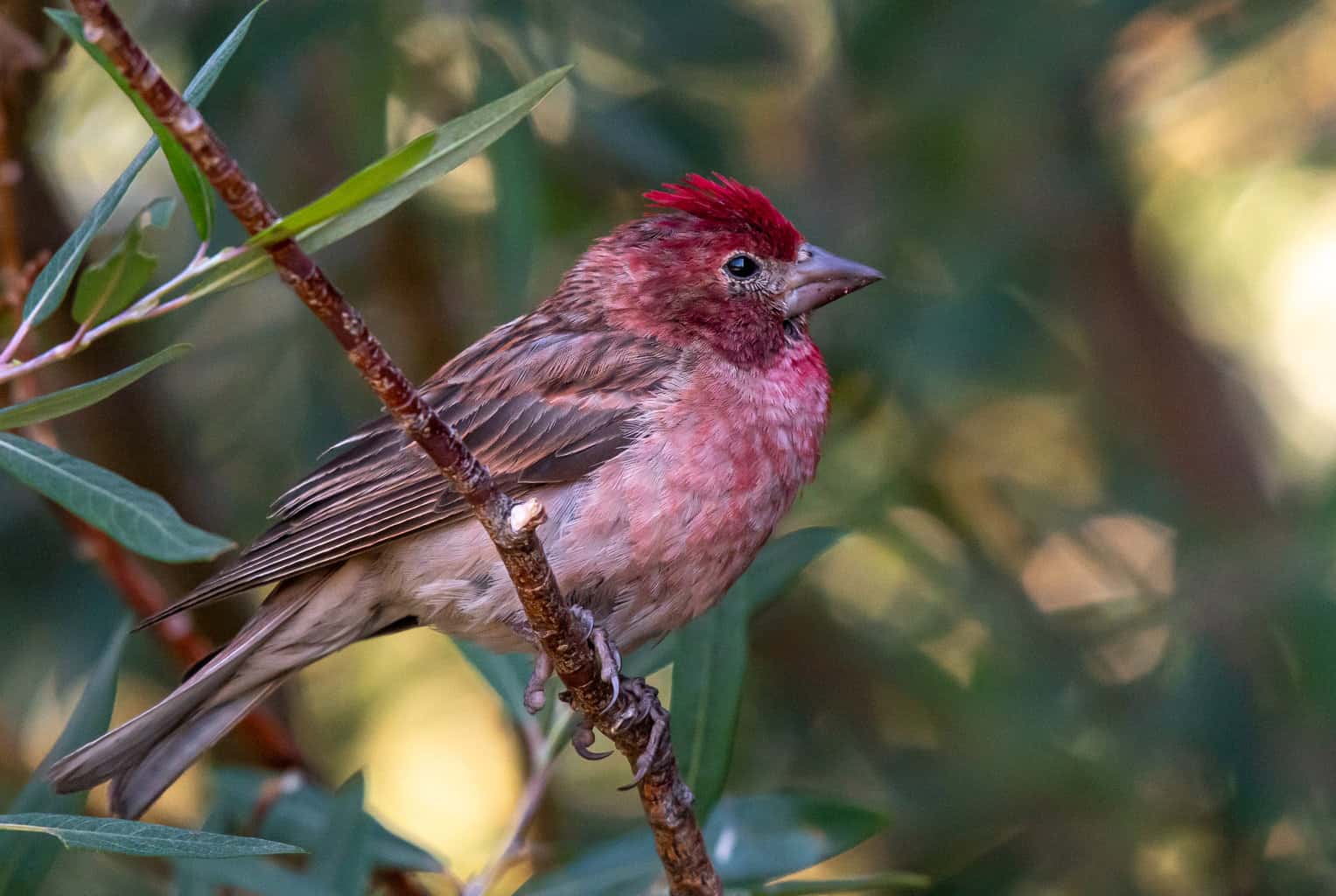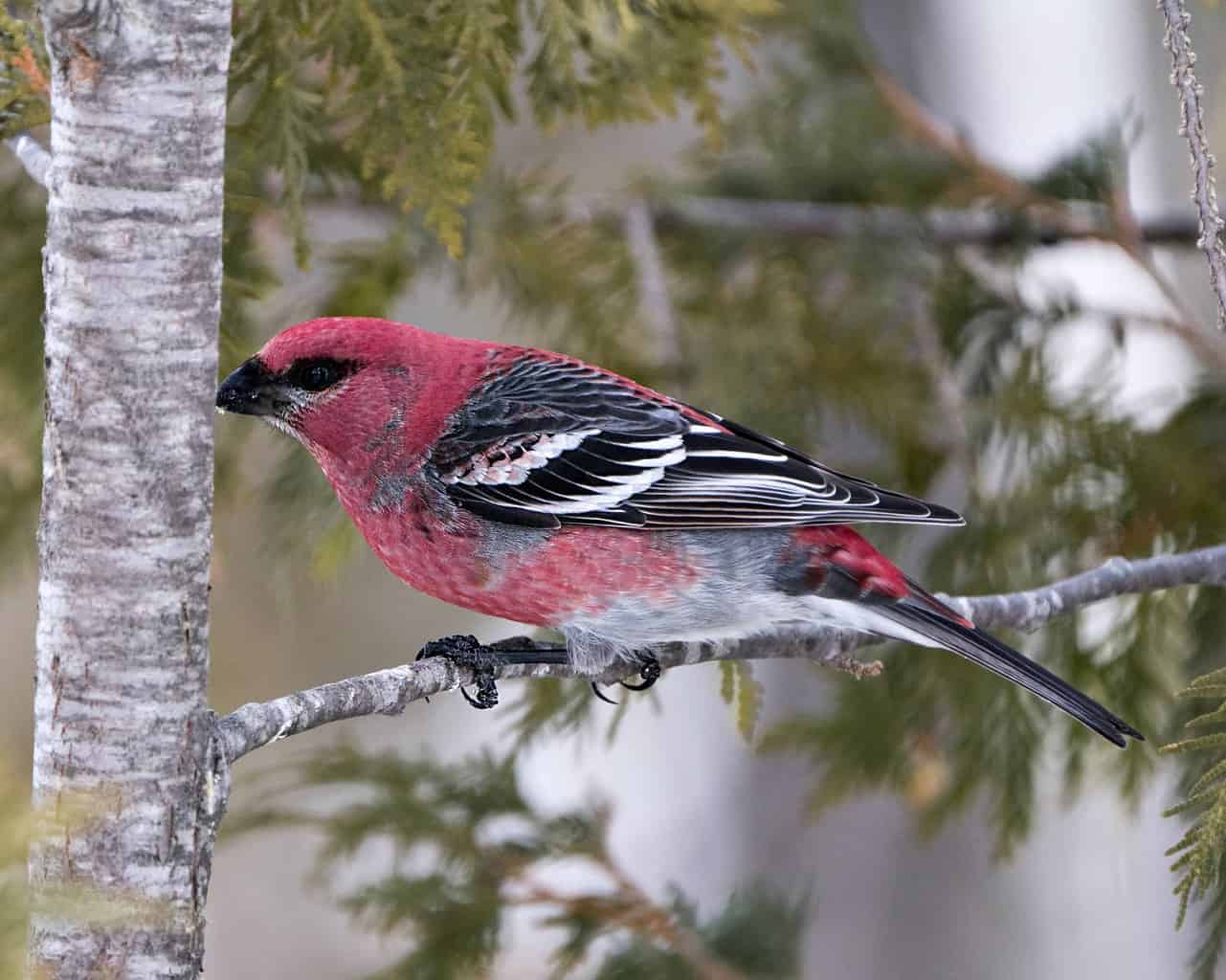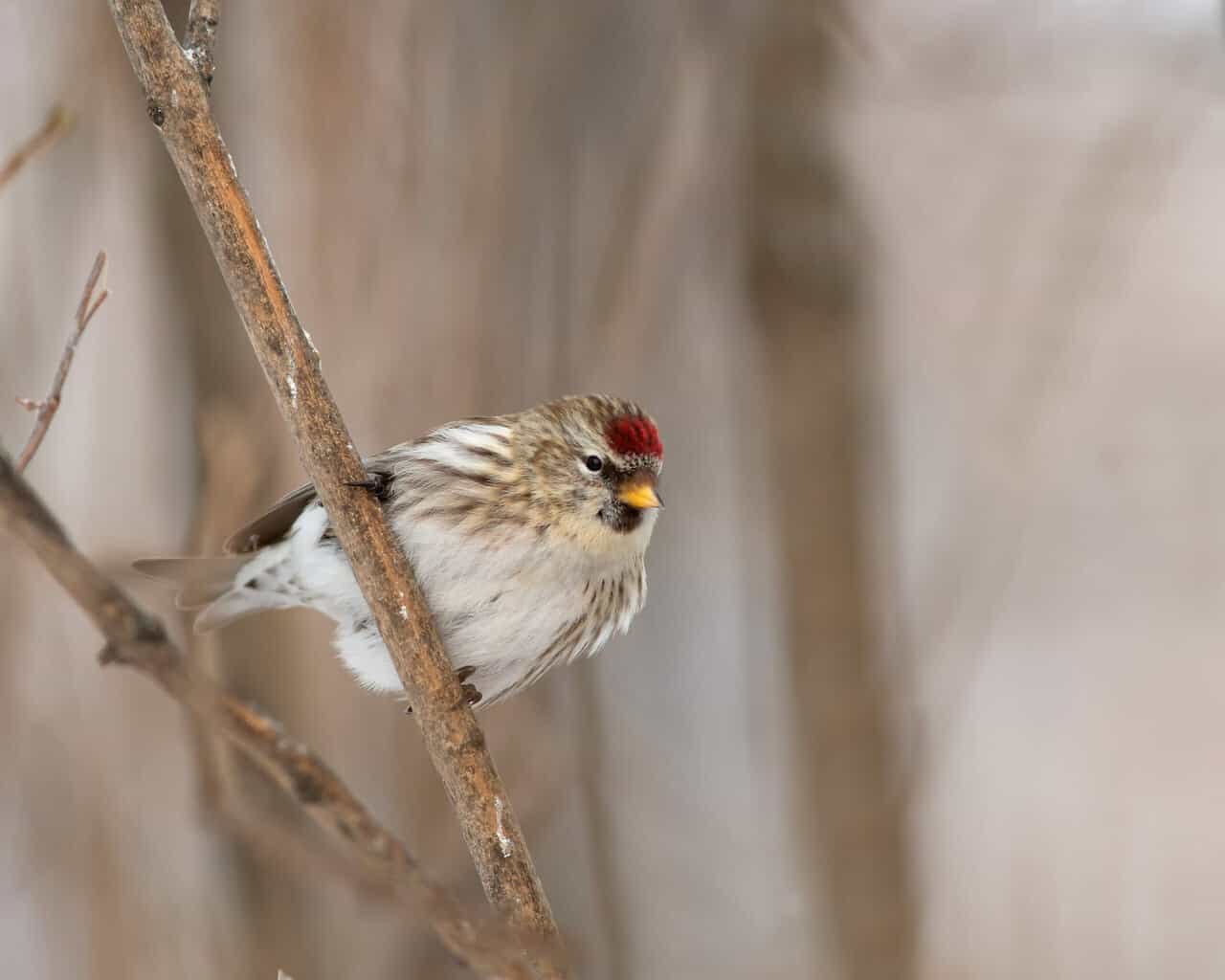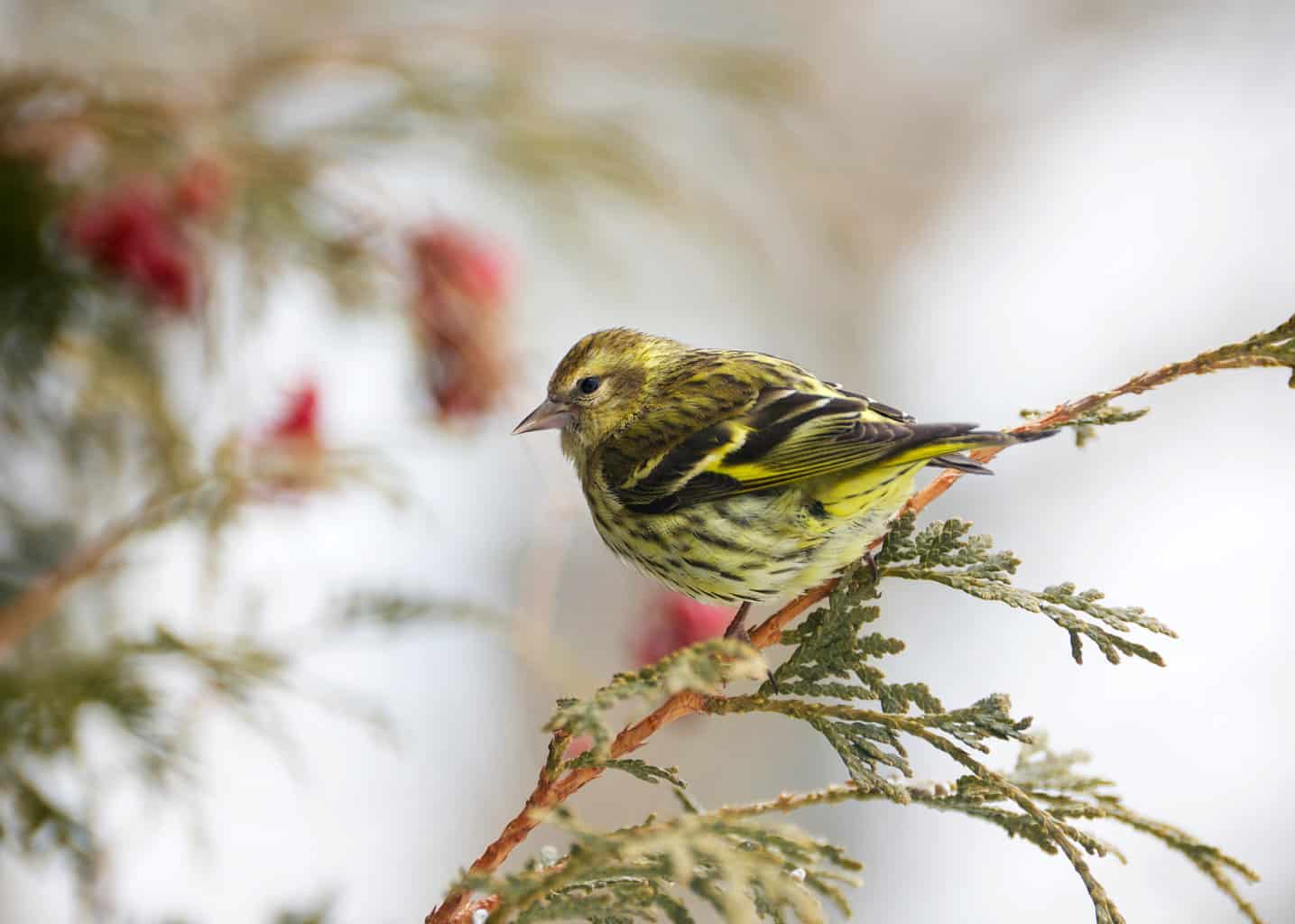Finches can be found just about anywhere with their diminutive forms, bright plumage, and conical beaks. Certain finch species are remarkably frost-resistant, while others are capable of settling down in valleys, plains, deserts, or even urban areas.
Some of them have also elected to live in America’s sixth-largest state, its arid climate, scorching sunshine, and abundance of predators notwithstanding.
As a matter of fact, 13 species of these winged granivores call the Grand Canyon State home. And they’re covered here so you can find out all you need to know about finches in Arizona.
Cassin’s Finch

- Scientific Name: Haemorhous cassinii
- Length: 6 inches
- Weight: 0.8 – 1.2 ounces
- Wingspan: 10 – 11 inches
A rather talkative bird, the male Cassin’s finch is stocky and dark-eyed with a finches’ characteristic conical beak.
This passerine can be recognized by the pink flush on its crown which fades to a paler pink blended with striated brown streaks on its face. Its chest feathers are also the same muted pink while its back feathers are a striated brown and black flushed with yet more pale pink.
The female on the other hand is a light brown (with a paler undersurface) covered in darker streaks. Rather gregarious by nature, members of the species can be found indulging in a diet that consists of insects, seeds, and fruit in the company of other close relatives.
The Cassin’s finch can be found in the northern and eastern parts of the state all year round including locations such as the Grand Canyon National Park and Tonto National Forest. It is also known to fly further south during winter, all the way to Mexico.
House Finch

- Scientific Name: Haemorhous mexicanus
- Length: 5 – 6 inches
- Weight: 0.6 – 0.9 ounces
- Wingspan: 8 – 10 inches
At first glance, the male house finch might seem like a somewhat smaller version of the Cassin’s finch.
Yet its head and chest are covered in pale pink feathers while the rest of its feathers are mostly brown streaked with black.
This extremely adaptable variety of finch can be found throughout the state of Arizona all year long. House finches can also be found in neighboring California, Nevada, New Mexico, and Mexico as well as a significant part of the United States.
American Goldfinch

- Scientific Name: Spinus tristis
- Length: 5.5 inches
- Weight: 0.4 – 0.7 ounces
- Wingspan: 8 – 9 inches
The aptly named American goldfinch is covered in yellow plumage which turns black at the crown and the wing (with a hint of white in the latter case).
Yet that rather striking coloring only appears in spring and in males. In fall the American goldfinch swaps its bright plumage for a more modest covering which is a muted yellow on its face and chest, olive brown on its upper surface, and brownish-yellow on its undersurface. This new plumage closely resembles its female counterpart.
The American goldfinch is equally at home in urban areas, woods, and open fields. The species tends to make an appearance in central Arizona.
Although it breeds in Canada, it travels south to spend the winter in a vast swathe extending eastwards from California to South Carolina.
Lawrence’s Goldfinch
- Scientific Name: Spinus lawrencei
- Length: 5.5 inches
- Weight: 0.4 – 0.7 ounces
- Wingspan: 8 – 9 inches
A rather distinguished-looking bird, the male Lawrence’s goldfinch is covered in gray plumage interrupted by a striking black mask, a splash of yellow on its chest, and beautiful barred feathers in yellow, black, and white at its wings and tail.
Rather fond of water, it can be found in trees close to the banks of streams and may occasionally winter in southwestern Arizona, southeastern California, and northwestern Mexico.
Lesser Goldfinch

- Scientific Name: Spinus psaltria
- Length: 3.5 – 5 inches
- Weight: 0.3 – 0.4 ounces
- Wingspan: 6 – 8 inches
The male of the species is covered in plumage which is dark at its crown and forehead, and which may be gray on its dorsal surface or olive.
Those colors give way to yellow at its chest and black and white at its wingtips. Females on the other hand exhibit the same black and white coloring at the wings but are generally olive-colored.
This species can be found all over Arizona preferring to breed in the northeast. Lesser goldfinches are also rather gregarious and gather with close and distant relatives during feeding times.
Evening Grosbeak

- Scientific Name: Hesperiphona vespertina
- Length: 6 – 9 inches
- Weight: 1.4 – 3 ounces
- Wingspan: 12 – 14 inches
Sturdily built with a short tail, the evening grosbeak is one of the larger species of finch. Males have a distinct yellow bar above their eyes, dark brown heads, and yellow coloring which covers their chests and part of their dorsal surfaces. Their wings are mostly white, edged thickly with black.
Females are covered in pale gray plumage with a pale band of yellow around the neck while their wings are similar in color to their males.
The evening grosbeak can be found in western Arizona, and most of New Mexico, throughout the year. It may also migrate eastwards towards Kansas, Illinois, Indiana, and Ohio as winter approaches.
Pine Grosbeak

- Scientific Name: Pinicola enucleator
- Length: 9 inches
- Weight: 2 – 3 ounces
- Wingspan: 13 inches
One of the largest members of the finch family, pine grosbeaks are rather stocky with dark wings and tail feathers, streaked with white.
The rest of the plumage on the male is dark red, while it is gray on the female. This species is rather curious and has been known to tolerate human scrutiny to a surprising degree.
Although it is mainly found in Canada, it is found in California, Utah, Nevada, and Colorado as well as eastern Arizona.
Common Redpoll

- Scientific Name: Acanthis flammea
- Length: 4.5 – 5.5 inches
- Weight: 1.12 ounces
- Wingspan: 8 – 9 inches
This compact small-sized species is covered in gray-brown plumage with hints of red below its chin, on the fringes of its chest, and on its crown in a dark patch.
The female of the species also has a dark red patch on its head while the rest of its plumage remains gray-brown with hints of white.
Its diminutive size notwithstanding, it is capable of thriving in cold weather and even visits the Arctic. This impressive quality is thanks in no small part to the presence of a throat pouch in which it can store surplus food to snack on at will.
Common redpolls can be seen in Arizona’s Grand Canyon National Park.
Black Rosy Finch

- Scientific Name: Leucosticte atrata
- Length: 6.5 inches
- Weight: 2 – 3 ounces
- Wingspan: 31 inches
Males of this medium-sized species of finch tend to be mostly dark-colored with hints of pink on their stomachs and rumps.
Females also share the same plumage streaked with brown and black with hints of white.
The black rosy finch is pretty adaptable in terms of its choice of habitat: it can be found in deserts, plains, or mountainous regions.
It can be found in northern Arizona as well as New Mexico to the east and further to the north in states such as Nevada, Utah, and Colorado.
Gray-Crowned Rosy Finch

- Scientific Name: Leucosticte tephrocotis
- Length: 5.5 – 6.3 inches
- Weight: 0.8 – 2 ounces
- Wingspan: 13 inches
As its name suggests, the gray-crowned rosy finch has gray head feathers and an occasionally black crown that may extend down its face to its chin. The rest of its body is covered in dark bronze plumage, while its wing feathers are black, edged with white with hints of pink which also extend to its chest region and its underparts.
This species can be found in a variety of habitats including plains, urban areas, and mountainous regions.
Pine Siskin

- Scientific Name: Spinus pinus
- Length: 4 – 5.5 inches
- Weight: 0.40 – 0.60 ounces
- Wingspan: 7 – 9 inches
This small-sized finch can be recognized by its brown and white plumage featuring noticeable streaks of a slightly darker brown. Its wings are also covered with hints of olive green.
Gregarious by nature, pine siskins are rather fond of feeding on sunflower seeds in the wild. As the weather cools, they head southwards from its breeding grounds in Canada to the United States and Mexico. However, certain members of the species live all year round in eastern and central Arizona and North America’s west and southwest.
Red Crossbill

- Scientific Name: Loxia curvirostra
- Length: 7.5 inches
- Weight: 2 ounces
- Wingspan: 12 inches
Males of this species are covered in coppery plumage which darkens at the wings and turns a pale gray-brown at their rear.
Females are generally gray-brown with hints of pale bronze at their chests and on their upper surfaces.
Both genders have gray crisscrossed bills which come in handy for prising open conifer cones.
Red crossbills can be found all year round in eastern Arizona as well as California, Colorado, Nevada, New Mexico, and as far north as Washington and Montana.
Two-Barred Crossbill

- Scientific Name: Loxia leucoptera
- Length: 6 – 7 inches
- Weight: 1 – 1.4 ounces
- Wingspan: 13 inches
A vivid red plumage interrupted by dark wings and a tail streaked with white, is the main distinguishing feature of the male of this species.
The female, on the other hand, is covered in gray-brown with hints of green on her head, face, and chest.
Both genders have that characteristic crisscrossed beak which enables them to get at the goodness concealed in conifer cones.
This species of finch has a habit of dangling upside down from branches and warning intruders not to get too close.
Its members are rather talkative and gregarious and can also be found in neighboring New Mexico as well as Colorado.
Conclusion
If you love finches, you will find there is no shortage of these lively colorful birds in Arizona. While some of them only make an appearance during winter, others have settled down nicely and can be found in the southwestern state throughout the year.
What’s more, these gregarious and often entertaining passerines can also be found in neighboring states.
And you can embark on the next step of your journey of discovery by reading about birds in Arizona. All so you can find out even more about the feathered residents of North America’s fourteenth most populous state.

